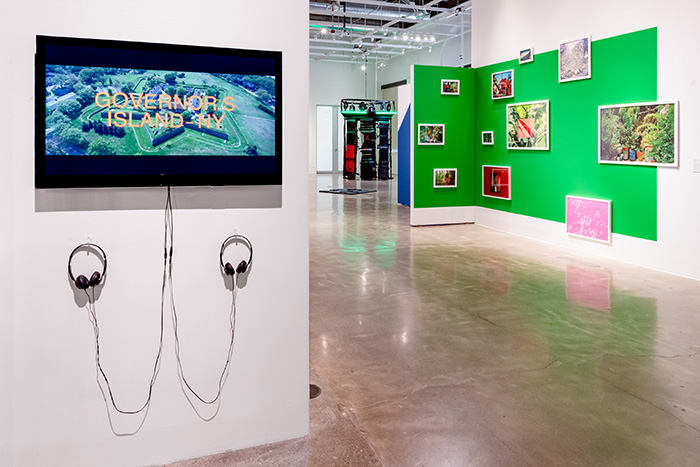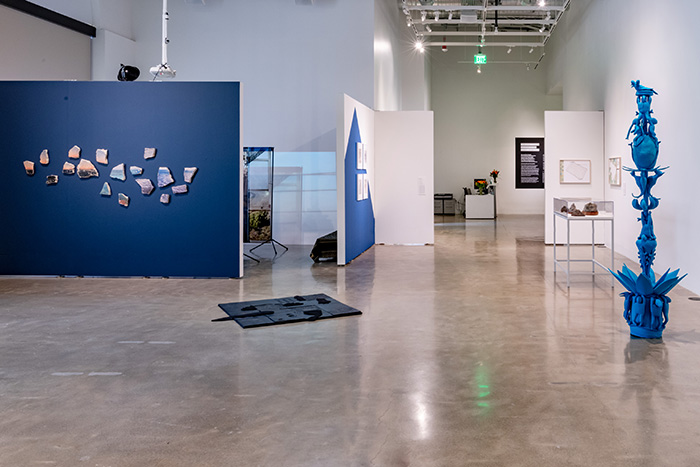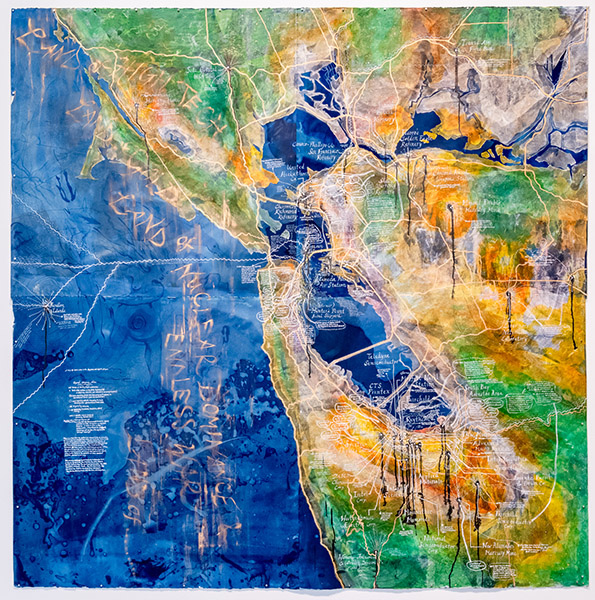We live in a time of contested landscape. Locally and globally we have disagreement regarding the state of our environment, the factualities of climate change, and who has rights to be somewhere, anywhere. Yet, many of us are ingrained with strong connections to specific locations—the places we inhabit, remember, and revere. Whether one believes in science or not, places are, in large part, the defining sources of many aspects of our collective and individual identities. The flora, fauna, climate, and experience of place are imprinted in our diverse and various cultures.
Transcending Physicality: The Essence of Place at San Francisco Arts Commission Gallery is an exhibition of 14 international artists curated by Minoosh Zomorodinia. The exhibition communicates perspectives about human engagement with natural and built environments, and crises of these via works charged with subliminal agendas and cool intellectualism regarding the (oftentimes harsh) realities of our relationships with the land.

Attention to place is an integral and valued part of our existence. Humans have been worshiping and celebrating specific locations and scenes—sunsets, horizons, mountains, and waterways—and noting the cycles of time and the change of seasons at particular locales throughout recorded history. A sense of place can be evoked from memories of experience, audio or physical stimuli, and visual prompts, whether actual or invented. The current ease and ubiquity of recording our environments digitally allow us to link the historical past with present day, ultimately documenting the landscapes occupying our minds. Many of the works in this exhibition mine memory, human and digital, to reveal the lingering essences of being in particular spaces. They are content rich with concepts well expressed in media and form. They reveal contemporary concerns and obsessions of the most immediate sort via a focus on artifacts of human actions, the impacts of these on their related environments, and efforts to make things better.
S. Emsaki provides the most iconic of the included work with point of entry. A tricone drill bit, the type used by extraction industries for drilling into earth, is displayed as an object of worship in a narrow corridor of intense red orange hue. This simple, yet poignant presentation of our global culture’s addiction to petrochemicals bites sharply, needless of words.
Tiare Ribeaux and Quanqian Ye have created a highly seductive, mesmerizing three dimensional animation which references The Great Pacific Garbage Patch. Kai-Hai: Plastia looks like polished glass and crystalline structures gyrating to hidden oceanic rhythms. The imagery is enticing, soothing, abstract, without obvious narrative. It references historical deities from East Asia to Hawai’i realized as a contemporary “Goddexx formed from the need to remediate microplastics from the ocean.”

Our shared horizon is an installation of 17 wall-mounted objects by yétúndé olagbaju. These irregularly shaped, works on travertine (a type of limestone often used as building material) are reminiscent of archaeological fragments, each printed with elements of a photographic sunset. As such, they are carriers of old and new photographic practices which record the iconic nature of the sunset photo phenomenon without apparent specificity to location. Together they evoke longing and loss sans any trace of sentimentality or kitsch.
In Clouds of the American West, Kelley O’Leary displays artifacts, site debris really—in an archeological style including museum vitrine—found while visiting data centers in Oregon, Nevada, California, Utah, and Arizona. The artifacts are secondary to the artist’s journey itself or the meaning this residue represents. Data centers act as archives of millions of peoples’ places via their photos in cloud storage. Our digital cameras’ roll aids our memories of fleeting experiences. Social media displays much of this soup, and the fact of the archive is probably not a concern for most people. Many of us will die and no one will ever see or “like” our photos but they are there in some data center along with millions of other peoples’ places. O’Leary points our attention to the fact that with or without our knowledge or permission, great amounts of our personal data are being archived (and likely mined) by mega corporations oftentimes housed in remote locations.

Land of Opportunity is a large scale mixed media drawing by Connie Zheng. This rendering of the greater Bay Area maps superfund sites (areas requiring long-term response to clean up hazardous material contaminations) alongside sites of citizen protests. The map is compelling in part by the seduction of seeing our home so beautifully rendered in a somewhat historical mapmaking style. The drawing is on a cyanotype print with layering of mulberry paper to create a topographical feel. These layers act to peel away the facia of history and reveal the deep harm enacted on the land. It can be heart stopping to learn that the Bay Area, a place described by Malcolm Margolin as being an actual Eden just two hundred years or so ago when Indigenous people managed the land, is now home to one of the largest collections of superfund sites in the country.
Curator Zomorodinia has selected works which transcend physical concepts and realities of place while being deeply layered with personal and environmental meaning. Walking the gallery is like taking a guided journey to 14 islands of rich contemplation with many of the works resonating long after returning to the street outside. Transcending Physicality is a landscape of profound memory bombs. “This is our home,” they whisper. “Look what we have done to it now.”
Transcending Physicality: The Essence of Place
Curated by Minoosh Zomorodinia
October 13–December 16, 2023
SFAC Main Gallery
War Memorial Veterans Building
401 Van Ness Avenue, Suite 126
San Francisco, CA 94102
Wednesday–Saturday, 12–5 pm
The exhibition features works by: Alex Arzt, Ebti, S. Emsaki, Kiana Honarmand, Masha Kechaeva, Carolina Maki Kitagawa Frisby, Nazafarin Lotfi, Lorena Molina, yétúndé olagbaju, Kelley O’Leary, Tiare Ribeaux and Quinqian Ye, Sanaz Safanasab, Supermrin and Jessica Fertonani Cooke, and Connie Zheng.